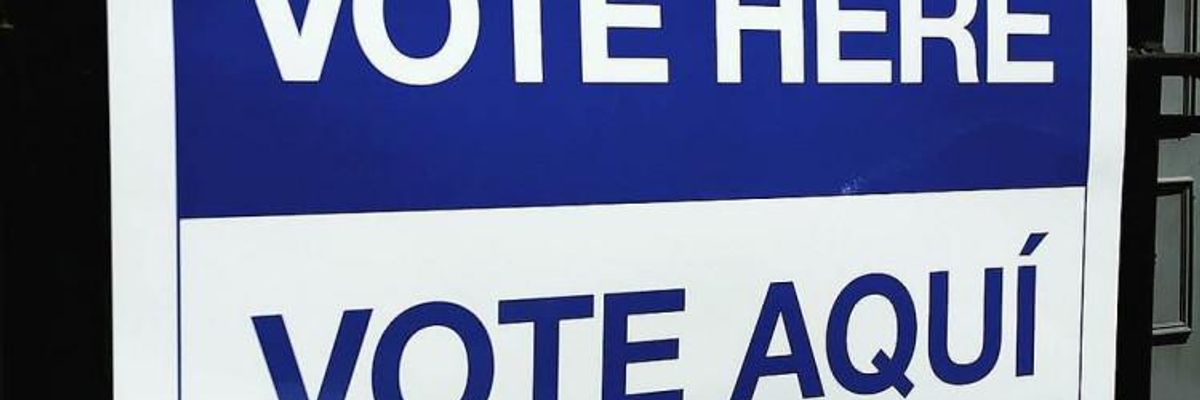At least 126,000 voters in Brooklyn, New York, were purged from voter rolls. The purge seems to be a symptom of the state's "closed primary" system, which forces voters to affiliate with a political party to vote. Yet, the disenfranchisement of so many voters in Brooklyn and in other parts of the state ahead of the primary on April 19 has most Democrats excusing what should be considered voter suppression.
"The fact is the 'closed primary' system in states like New York is the two-party system's key mechanism for maintaining control over elections in the face of trends, where fewer and fewer Americans wish to affiliate with one of the two most prominent parties in the United States."
The concept of a "closed primary" is the idea that voters should formally affiliate with a political party if they would like to vote in that party's primary. There is nothing particularly nefarious about the idea, however, in practice, it makes it much easier for the leadership of the two most prominent parties to maintain the status quo.
The New York primary is a glaring example of how primaries are managed in ways which protect the political establishment. The date to declare one's party affiliation was ridiculously early in the election, on October 9. Even though one could register to vote up until March 25, back in October no voter would have thought Bernie Sanders would be in a competitive contest against Hillary Clinton in April.
Ari Berman, a journalist for The Nation, reported around 27 percent of registered voters would not be able to vote in the primary because it is "closed."
The widespread perception is all of these people should not be allowed to vote because parachuting into an election when they have no allegiance to a party is wrong. But Brooklyn shows this is impacting Democratic and Republican voters. It is significantly affecting first-time voters.
The New York City Board of Elections "removed 126,000 Brooklyn Democrats from the rolls," WNYC reported. Twelve thousand people, who moved out of the borough, 44,000 were moved from active to inactive voter status, and 70,000 voters were removed from the inactive voter list entirely. While some of these people should be purged, there is no clear reason why there would be a 14 percent drop in Democrats.
Remarkably, New York has three primaries in 2016. The next two are on June 28 for Congress and September 13 for state and local offices. Berman suggested this was probably designed to keep high voter turnout on April 19 from benefiting candidates running for state or local offices.
Hundreds of voters sued New York ahead of the primary in order to force state officials to make it an open primary. One plaintiff, Joanna Viscuso, a 19 year-old, registered to vote as a Democrat in 2014 at her college orientation. She noticed last week that her voter registration now claimed she was "not affiliated" with a party. After calling her county's Board of Elections, she was informed in September she filled out a form "to change her party affiliation and sent it in October." However, she never did such a thing.
Attorneys with Election Justice USA went before a judge during the afternoon of the New York primary. According to The Young Turks' Jordan Chariton, the judge informed the attorneys and voters they needed to bring in representatives from all the counties of New York state to defend the voter registration process. It is impossible to get all the representatives together within hours so a hearing was scheduled for later. The judge also said voters could fill out provisional ballots if they were purged and contest the election outcome. But there would be no relief for tens of thousands of voters unable to participate the day of the primary.
Countless people have reported on social media that they went to vote and found their party affiliation was inexplicably changed. This is a serious problem, but what Bernie Sanders, his supporters, and thousands of voters get for complaining is a response that this is not really voter suppression.
For example, on Twitter, The New Republic's Jamil Smith questioned whether what happened in New York's "closed primary" system was voter disenfranchisement. He declared, "The more folks in New York act like their votes are being suppressed by annoying deadlines, the less focus we put on actual suppression."
Others went on about how poll taxes, literacy tests, and grandfather clauses are "real" types of voter suppression, but not what happened in New York's "closed primary" system.
The fact is the "closed primary" system in states like New York is the two-party system's key mechanism for maintaining control over elections in the face of trends, where fewer and fewer Americans wish to affiliate with one of the two most prominent parties in the United States.
In January, Gallup reported the number of Americans, who affiliate as Democrats or Republicans were near "historic lows." The number of people who describe themselves as independents has risen sharply to four out of ten Americans during the last five years.
As the New York primary has demonstrated, even if the idea of "closed primaries" is acceptable in democracy, in its execution it deprives too many voters of their right to participate in elections.
It is no coincidence that many of the same people who show indifference toward voter disenfranchisement in the "closed primary" system also are the ones diminishing the significance of Clinton's dependence on corporate and special interest money to compete in the primary against Sanders. Both stances reinforce the political status quo, which the Sanders campaign has undermined simply by its unwillingness to adhere to a script the Democratic National Committee would like the campaign to follow.

